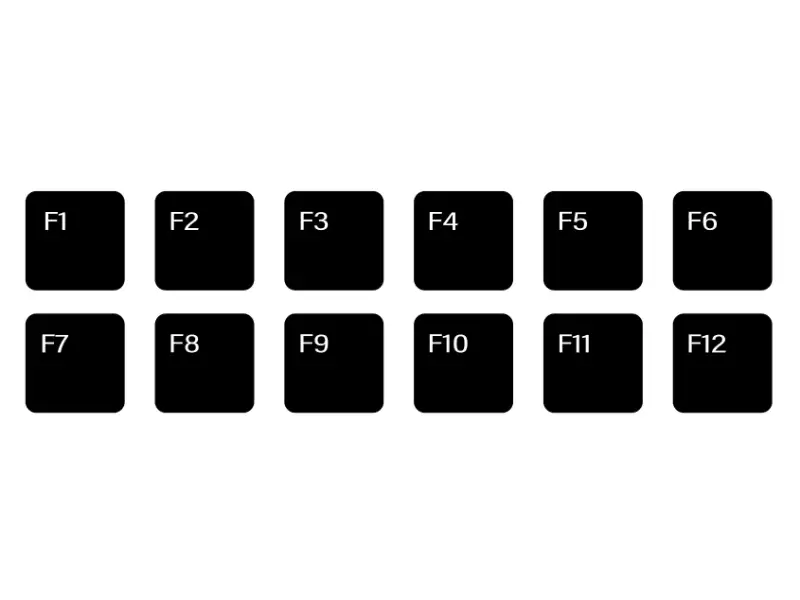Disclaimer: This post may contain affiliate links, meaning we get a small commission if you make a purchase through our links, at no cost to you. For more information, please visit our Disclaimer Page.
Have you ever wondered what the function keys are for?
The F1 to F12 function keys provide shortcuts when using the Windows Operating System. The keys help you work faster and more productively. Some work on boot-up, others work with your browser, while others work with running programs such as MS Office applications.
Table of Contents
What Is the Function of Key F1 To F12?
Each of the F keys has its own specific functions. Let’s take a look at how you can save time and get more work done by using these keys.
F1
Opens the help page of the program you’re using.
F2
Enables the user to rename a selected file or folder. In some MS Office programs, using the F2 plus Ctrl button simultaneously opens the print preview.
F3
Opens the search box for the open application. F3 also repeats the last command when you’re using the Command Prompt window.
F4
Clicking F4 plus the Alt button simultaneously closes a running application. Ctrl plus F4 opens the active tab on your browser while Alt plus F4 closes the active window on your browser.
F5
F5 is most commonly used to refresh an active web page. Using F5 plus Ctrl clears a browser’s cache.
F6
The F6 button highlights the URL in the address bar of the active tab of your browser.
F7
When using a browser, you can use the F7 button to turn your cursor from a pointer to a vertical line. In effect, the F7 switches the user from keypad browsing to caret browsing.
F8
The F8 is used on startup before the operating system loads to open the boot menu. By pressing it repeatedly on startup, you can access advanced startup modes such as starting windows in safe mode.
F9
The F9 button triggers MS Outlook to ‘Send and Receive’ any pending emails.
F10
The F10 button activates the use of the menu of the running program. Using Shift plus F10 works the same as right-clicking with your mouse.
F11
The F11 toggles between full screen and normal screen modes when you’re using a web browser.
F12
The F12 button is a beloved shortcut for developers. When using a browser, it opens the developer tools. In MS Office applications such as MS Word, F12 will open the ‘Save As’ dialogue box.
How Do I Use the F1 To F12 Function Keys?
The F1 to F12 keys are shortcut function keys designed to help you access some functions faster and without fuss. Here are a few ways you can use each F key:
F1
You can use the F1 key in MS Excel and MS Word to bring up the help sidebar. In older versions, the F1 key hides or displays the menu ribbons.
Pressing the F1 button plus the Windows button simultaneously opens a help tab in Windows Edge. in some Windows versions, F1 plus Windows buttons opens the ‘Help’ menu of the running application.
F2
In MS Word, the F2 button selects all text and objects. In excel, pressing F2 allows the user to edit the active cell.
When you press F2 plus Ctrl simultaneously in MS Office programs, it opens the print preview. F2 plus Ctrl plus Alt opens the Document Library while Alt plus shift plus F2 opens the ‘Save As’ dialogue box.
F3
F3 opens the search box in an active web page so you can search for a word, phrase, digit, or special character. In MS Word, pressing shift plus F3 toggles your text between sentence case, lowercase, and uppercase.
F4
When using Explorer, the F4 buttons highlight the URL in the address bar. Pressing F4 plus Alt closes the running program or browser window.
F5
The F5 button refreshes the active tab when using your browser. If you’re using Notepad, the F5 button inserts the current date and time. If you’re using MS PowerPoint, the F5 button starts a slideshow from the beginning.
F5 plus Ctrl refreshes a web page while also clearing cache and downloading all content afresh.
F6
When using your browser, the F6 button toggles between highlighting the URL in the address bar, then highlighting the active tab, then back to the on-page cursor.
In MS Word, the F6 button toggles between highlighting the navigation bar, the page numbers, and the standard menu items.
F7
The F7 button runs the spell checker in MS Office. When using your browser, the F7 will turn on and off caret browsing.
F8
In MS Word, the F8 button highlights text from the top of the page to the cursor placement. On bootup, the F8 key enables starting in safe mode.
F9
The F9 key refreshes a document in MS Word. It also triggers the refresh function of MS Outlook to send and receive any pending emails. F9 plus Ctrl inserts empty fields in MS Word.
F10
The F10 button activates use of the menu in the active program. You can then use your keyboard to access menu items rather than using your mouse. F10 plus shift works the same as a mouse right-click.
F11
The F11 button enters and exits full screen mode when working on your browser. F11 plus shift button opens a new sheet in MS Excel.
F12
In your browser, the F12 button enters and exits developer tools. In MS Office, the F12 button opens the ‘Save As’ dialogue box.
Can You Reverse F1 To F12 Keys?
While most people use the keyboard in its default setting, others like to customize the functions they use most often. There are several ways you switch out how you use the F1-F12 function keys.
In BIOS
- Restart your computer.
- As the computer boots up, press F12 or Fn+F12.
- If the computer opens in BIOS, it will bring up a menu for devices.
- Go to ‘App Menu’ then click on ‘Setup.’
- In Setup, go to ‘Hotkey Switch’. You can change your settings from ‘Hotkey Mode’ to ‘Legacy Mode.’
- Exit and save.
- Restart the computer.
People working with office applications prefer Hotkey mode while gamers prefer Legacy mode.
Keyboard Software
If you’re using a desktop with an external keyboard, the keyboard likely came with installation software. With most keyboards, there’s an option for customizing your hotkeys.
Using the keyboard software is the most comprehensive way to remap keys. You can change multi-key combinations such as Alt+F4 and even create new combinations.
Third Party Software
There are several third-party programs which enable users remap buttons on their keyboards. Some leading and popular software solutions for reversing your F1 to F12 function keys include:
- SharpKeys
- KeyTweak
- Key Mapper
- Microsoft Keyboard Layout Creator
- HotKeyBind
- Key Remapper
F1 to F12 Keys Not Working: How to Fix Them?
To fix your function keys, you need to do the following (all detailed below):
1. Restart your computer
The only way to get to your System BIOS is to restart your computer. Once there, you can reverse your Function keys.
Restarting your computer is as simple as hitting the Windows key (or clicking the Windows button), clicking Power Options and selecting Restart.
2. This will require you to interrupt your computer’s normal startup process (hit Enter on the launch screen).
As your computer restarts, when you see your computer’s logo onscreen, press Enter (or whatever it says to press). On my Lenovo, it says: “To interrupt normal startup, press Enter”.
3. Enter the BIOS of your system
Hit F1 to enter the BIOS Setup utility once the Startup Interrupt Menu loads.
For those of you with different startup menus, just follow the prompt to access the BIOS Setup Utility.
Click on the Keyboard/Mouse setup
Follow these steps to get to the Keyboard/Mouse setup:
1. Hit the right arrow key to navigate to the Config tab
2. Highlight Keyboard/Mouse with the down arrow key and press Enter.
3. Set the F1-F12 keys as the primary function keys
The F1-F12 keys, located in the dialog box that opens, can be reversed.
I have enabled Primary Function [Enabled] on my Lenovo computer.
Alternatively, you can disable the F1-F12 keys and set your media keys as the dominant keys (which is what most laptop computers do nowadays).
4. After saving, exit
Now that your function keys are flipped, hit F10 to save and exit the BIOS utility.
To fix your functions keys, you’ll need to reboot your computer and make a few changes to your System BIOS. As such, I recommend re-opening this page on a separate computer screen, such as an iPad, so you can follow along.


